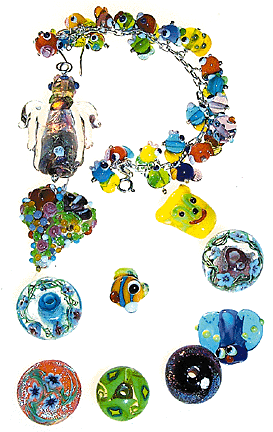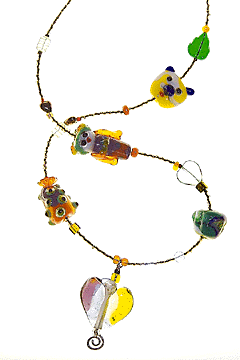


Artisans carry a torch for
this age-old method of
making beadsHow do they do it?
By Stephanie Kendrick
Assistant Features Editor
Star-BulletinIn the alien conspiracy spoof "Men in Black," the universe everyone is trying to find turns out to be housed in a marble-sized gem on a cat's collar. The alien investigators are thrown off the trail because they are expecting a universe to be, well, big.
The movie could have been a lot shorter if they had put a lampwork bead maker on the case.
Lampworking is a process of molding glass in the flame of a gas-powered torch. The art was largely confined to Italy until the middle of this century and only caught on with American artists in the late 1980s.
It results in a bead made of many layers of different colored glass; some already shaped into hearts, flowers and other objects; some incorporating a light-bending metallic sheen.
It's easy to see an imaginary universe in these tiny works of art.
A world of flowers
Jamie Lyn Yoshida, owner of The Bead Gallery on Kapiolani Boulevard, is at least partly responsible for lampworker Calvin Orr's recent move to Hawaii from San Jose, Calif. They met at a mainland bead show and have formed something of a mutual admiration society.Yoshida was one of the first Hawaii beaders to tackle lampworking. While Orr and others say she has quite a talent for it, she no longer makes many of her own beads. "Now that I have a store, it's less and less," said Yoshida. But she is always on the lookout for lampworkers to showcase and she was particularly excited by Orr's work.
The delicacy of Orr's beads are incongruous with his rough, tattoo-covered exterior. Orr's resume includes stints as a computer cable fabricator, janitor and tattoo artist. But it was his work in stained glass that brought him to lampworking.
Three or four years ago, bead artists began to use the facilities at the studio where he was working. He decided to try beadmaking and was quickly hooked. He signed up for classes and built a workshop of equipment and tools he largely engineered himself.

The captivating details that comprise an Orr bead spring from the fact that he is at least as fascinated with the process and tools of bead making as he is skilled in the actual molding of the glass. For example, Orr makes his own glass canes. Most bead makers buy their canes, usually from Italian suppliers."Canes" and "stringers" form the lampworkers palette. Canes are rods of glass that can be a solid color or a combination of colors in a design. The design elements in a cane can be inserted in a glass bead during lampwork. Stringers are thinner rods of colored glass that have been heated and pulled. They also can be used to create details on a bead.
Orr's specialty is the plumeria and he is perfecting his method for putting veins in the petals of the flowers.
"I've been doing pretty good with the flowers," said Orr, who is modest and given to understatement. The results of his flower canes are amazing. Orr also has made canes with hearts, stars and other shapes.
He is working on a fish cane but has not made one he is happy with. "I've been totally baffled by it."
Orr has a reputation for being generous with the products of his unique skills. "He shares," said fellow lampworker Brenda Yonamine.
Orr is now learning to work with silver so he can set his cabochon beads. Retailers want to sell the cabochons, but customers will not buy them loose and they don't fit into standard bezel settings. So he is building settings for them.
"This is my art work that I want to get out there," said Orr. "I just hope somebody likes it so I can make more."
A world of color
Brenda Yonamine also has been doing lampwork for about three years. Born and raised in Hawaii, Yonamine was a special education teacher at Kawananakoa Intermediate School for 22 years.For her, lampworking was a natural progression from making jewelry using beads crafted by others.
"I love beads," she said.
While Orr's beads are spherical, Yonamine creates beads of representative shapes. She recently made a Jackie Chan figure in honor of the actor/martial arts mater's scheduled appearance at the Narcissus Festival.
"Brenda is one of the best sculptural lampworkers I've ever seen," said Yoshida of The Bead Gallery.
Although cat beads sell well, and Yonamine likes cats, she doesn't enjoy making cat beads. But she does like to make animal beads, "especially dogs."
Bees and fish were added to her repertoire at the suggestion of customers and she has found she particularly enjoys making fish. They lend themselves to her colorful style and are economical to create. "I use up all the scraps of glass that breaks," she said.

Another of Yonamine's specialties is angel beads. They grew out of her experience with breast cancer in 1997. She had a lumpectomy and went through radiation therapy. At a Christmas party for breast cancer survivors put on by Kapiolani Medical Center for Women and Children, many of her fellow survivors said they felt they had a guardian angel that had helped them through the treatment. So she started crafting guardian angels that hang from a pink ribbon, the breast cancer symbol.The following October, breast cancer awareness month, she gave more than 100 angels to breast cancer patients through their doctors.
Yonamine enjoys the creativity involved in lampworking and enjoys learning new techniques through classes. She recommends Dacs Beads in Kalihi for anyone wanting to learn.
She has continued to develop her work by keeping an eye on other artists. She said imitation is the best way to learn new techniques and grow as an artist, though she's quick to add that it is just the start of the process.
"First you imitate, then you move on," she said.
A world of whimsy
Charlene Tashima, owner of Kapakahi Beads, was born and raised in Hawaii. She owned and operated Gallery Eas -- specializing in modern Japanese prints and the work of local ceramists -- for 15 years before closing in 1993."It was time to pursue my own thing," she said.
Tashima continued to sculpt clay and began making beaded jewelry. "I've always wanted to do glass beads but I thought, no, I can't do it by myself." Then she met partner Joel Park through her work with clay and they started taking glass classes. She has been lampworking for nearly two years now, and describes her pieces as whimsical.
"Even in clay I do whimsy things," she said.
While Tashima makes some spherical beads, most of her pieces are colorful, fantastical figures that defy easy description.
Customers will sometimes ask her what a particular bead is supposed to represent. "Is it a bee? Well, it's whatever you want it to be," said Tashima. "One of my purposes when I look at these things is to be able to make something that when someone looks at it they smile.
"They all have big eyes and big smiles," she said. "Being in the selling of art, I've seen a lot of serious stuff and it's good too. But I think people need to laugh a little bit more." She gets some of her inspiration from newspaper comics pages, especially animal strips.
When Tashima designs a necklace she starts with the center bead (which doesn't always wind up in the center by the time she is finished), then adds the small "seed" beads that cover most of the wire. Lampwork beads or other adornments are added to bring out the colors.
She also makes her own clasps out of heavy silver wire. She experimented with pre-made clasps but couldn't find one she liked. Her hand-made clasps suit the style of her beads.
Tashima never thought glass beads would turn into a money-making endeavor, but people are buying at Art a la Carte at Ward Centre, where she works Saturday afternoons until closing. "It's so much fun to see pieces go home with someone."
She's nowhere near able to pay herself an hourly wage, the conventional goal for independent laborers, but she's happy making and selling her creations.
"Like anything in art, you have to start somewhere," she said.
How do they do it?
'You have to be in the moment;
By Stephanie Kendrick
It's like an escape'
Assistant Features Editor
Star-BulletinLampworking is the process of melting and molding glass over an oxygen/propane torch that heats up to 2,000 degrees.
The tip of a glass cane is melted into a ball atop a stainless steel mandrel with a clay-coated tip to allow for release of the molded glass.
Colors are added to the bead-in-progress through the use of much thinner rods of pulled glass called stringers. Designs are added through canes that have been built to contain shapes such as flowers or stars, or abstract groups of color.
After the bead has been completed, it is placed in a kiln to be fired and cooled. Without the kiln treatment, the stress of cooling will crack lampworked glass.
Graphite pads and molds are used in the bead-making process because graphite will not stick to the molten glass. Water baths are used to get hot glass off of tools.
Tools and glass frequently need to be wiped down with alcohol because dust is bad for the process, as is the grime that can build up on canes and stringers.
The grime, called smoot, and air bubbles also can form if the bead is not evenly heated during the lampworking process, said lampworker Calvin Orr.
It is a fascinating and rapid process. "You're in the moment," said Orr. "It's like an escape."
Despite the rapid and unstoppable process of making a lampwork bead, all the artists interviewed tended to turn on their torches without firm plan for the bead they were about to make.
Lampworker Charlene Tashima said each creation forms itself out of the glass as she works. But that leaves no room for hesitation. "Your decision has to be instantaneous," she said.
In addition to being intense, lampworking can be hazardous. "Sometimes when you get really tired, you get hypnotized by this flame," said Tashima.
And despite arm coverings and protective glasses, minor burns are common for lampworkers, as are injuries from flying glass, which has a tendency to explode.
According to lampworker Brenda Yonamine, some colors combust more violently than others, with yellows being particularly volatile. She has had glass shards lodge in her lip and chest.
Where to find them
CALVIN ORR Retail outlets: The Bead Gallery and its Web site, thebeadgallery.com; Rainbow Collection; over the Internet at Sundance Art Glass's Web site, artglass1.com; select California stores and at craft fairs.
Price range: $3-$30 for round beads, $16 for cabochons.
BRENDA YONAMINE
Retail outlets: The Bead Gallery and its Web site, thebeadgal lery.com; Rainbow Collection; Ihilani Resort and Spa; A New Season; Best of Friends; and on the mainland through bead distributors.
Price range: Most beads range from $8-$24; fish beads are $3-$5; fish bracelet is $44 with 12 fish and $60 with $18.
CHARLENE TASHIMA
Retail outlets: Necklaces at Art a la Carte, the Gallery at Ward Centre; The Art Plantation in Haleiwa; Four Calling Birds on Kapahulu; Bibelot in Kaimuki; Java Rama and Blind Fish Tank in Moiliili; and on the mainland through bead distributors. Beads available locally only at craft fairs. Next is the Bead Hoolauleia, April 24, at Ward Centre.
Price range: $30-$50 for necklaces. $5-$10 for beads.
Click for online
calendars and events.